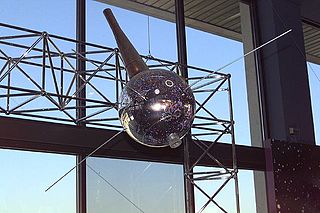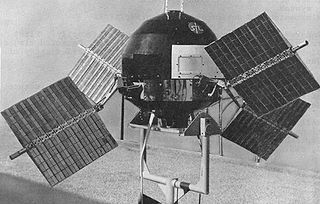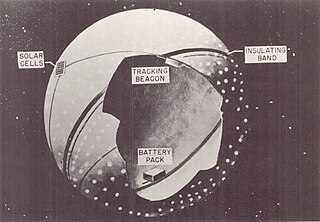
Vanguard 1 is an American satellite that was the fourth artificial Earth-orbiting satellite to be successfully launched, following Sputnik 1, Sputnik 2, and Explorer 1. It was launched 17 March 1958. Vanguard 1 was the first satellite to have solar electric power. Although communications with the satellite were lost in 1964, it remains the oldest human-made object still in orbit, together with the upper stage of its launch vehicle.

Vanguard 3 is a scientific satellite that was launched into Earth orbit by the Vanguard SLV-7 on 18 September 1959, the third successful Vanguard launch out of eleven attempts. Vanguard rocket: Vanguard Satellite Launch Vehicle-7 (SLV-7) was an unused Vanguard TV-4BU rocket, updated to the final production Satellite Launch Vehicle (SLV).

Project Echo was the first passive communications satellite experiment. Each of the two American spacecraft, launched in 1960 and 1964, were metalized balloon satellites acting as passive reflectors of microwave signals. Communication signals were transmitted from one location on Earth and bounced off the surface of the satellite to another Earth location.

Explorer 6, or S-2, was a NASA satellite, launched on 7 August 1959, at 14:24:20 GMT. It was a small, spherical satellite designed to study trapped radiation of various energies, galactic cosmic rays, geomagnetism, radio propagation in the upper atmosphere, and the flux of micrometeorites. It also tested a scanning device designed for photographing the Earth's cloud cover. On 14 August 1959, Explorer 6 took the first photos of Earth from a satellite.

Satellite geodesy is geodesy by means of artificial satellites—the measurement of the form and dimensions of Earth, the location of objects on its surface and the figure of the Earth's gravity field by means of artificial satellite techniques. It belongs to the broader field of space geodesy. Traditional astronomical geodesy is not commonly considered a part of satellite geodesy, although there is considerable overlap between the techniques.

Explorer 52, also known as Hawkeye-1, Injun-F, Neutral Point Explorer, IE-D, Ionospheric Explorer-D, was a NASA satellite launched on June 3, 1974, from Vandenberg Air Force Base on a Scout E-1 launch vehicle.

Submillimeter Wave Astronomy Satellite is a NASA submillimetre astronomy satellite, and is the fourth spacecraft in the Small Explorer program (SMEX). It was launched on 6 December 1998, at 00:57:54 UTC, from Vandenberg Air Force Base aboard a Pegasus XL launch vehicle. The telescope was designed by the Smithsonian Astrophysical Observatory (SAO) and integrated by Ball Aerospace, while the spacecraft was built by NASA's Goddard Space Flight Center (GSFC). The mission's principal investigator is Gary J. Melnick.
The Minitrack Network was the first U.S. satellite tracking network to become operational, in 1957. It was used to track the flights of Sputnik, Vanguard, Explorer, and other early space efforts. Minitrack was the progenitor of Spacecraft Tracking and Data Acquisition Network (STADAN) and the Manned Space Flight Network (MSFN).
NOAA-13, also known as NOAA-I before launch, was an American weather satellite operated by the National Oceanic and Atmospheric Administration (NOAA). NOAA-I continued the operational, polar orbiting, meteorological satellite series operated by the National Environmental Satellite System (NESS) of the National Oceanic and Atmospheric Administration (NOAA). NOAA-I continued the series (fifth) of Advanced TIROS-N (ATN) spacecraft begun with the launch of NOAA-8 (NOAA-E) in 1983. NOAA-I was in an afternoon equator-crossing orbit and was intended to replace the NOAA-11 (NOAA-H) as the prime afternoon (14:00) spacecraft.

The Unified S-band (USB) system is a tracking and communication system developed for the Apollo program by NASA and the Jet Propulsion Laboratory (JPL). It operated in the S band portion of the microwave spectrum, unifying voice communications, television, telemetry, command, tracking and ranging into a single system to save size and weight and simplify operations. The USB ground network was managed by the Goddard Space Flight Center (GSFC). Commercial contractors included Collins Radio, Blaw-Knox, Motorola and Energy Systems.

GEOS-3, or Geodynamics Experimental Ocean Satellite 3, or GEOS-C, was the third and final satellite as part of NASA's Geodetic Earth Orbiting Satellite/Geodynamics Experimental Ocean Satellite program (NGSP) to better understand and test satellite tracking systems. For GEOS 1 and GEOS 2, the acronym stands for Geodetic Earth Orbiting Satellite; this was changed for GEOS-3.

Laser communication in space is the use of free-space optical communication in outer space. Communication may be fully in space or in a ground-to-satellite or satellite-to-ground application. The main advantage of using laser communications over radio waves is increased bandwidth, enabling the transfer of more data in less time.

Explorer 19,, was a NASA satellite launched on 19 December 1963, as part of the Explorer program. It was the third of six identical Explorer satellites launched to study air density and composition, and the second to reach orbit. It was identical to Explorer 9.

Explorer 27 was a small NASA satellite, launched in 1965, designed to conduct scientific research in the ionosphere. It was powered by 4 solar panels. One goal of the mission was to study in detail the shape of the Earth by way of investigating variations in its gravitational field. It was the third and last of the Beacons in the Explorers program. The satellite was shut off in July 1973 so that its transmission band could be used by higher-priority spacecraft.

Explorer 22 was a small NASA ionospheric research satellite launched 9 October 1964, part of NASA's Explorer Program. It was instrumented with an electrostatic probe, four radio beacons for ionospheric research, a passive laser tracking reflector, and two radio beacons for Doppler navigation experiments. Its objective was to provide enhanced geodetic measurements of the Earth as well as data on the total electron content in the Earth's atmosphere and in the satellite's immediate vicinity.
Explorer 36 was a NASA satellite launched as part of the Explorer program, being the second of the two satellites GEOS. Explorer 36 was launched on 11 January 1968 from Vandenberg Air Force Base, with Thor-Delta E1 launch vehicle.

Explorer 39, also known as AD-C, was a NASA scientific satellite belonging to series Air Density. It was launched on 8 August 1968, join with Explorer 40, from Launch Complex 5 of the Vandenberg Air Force Base, through a Scout launch vehicle.
NOAA-10, known as NOAA-G before launch, was an American weather satellite operated by the National Oceanic and Atmospheric Administration (NOAA) for use in the National Environmental Satellite Data and Information Service (NESDIS). It was the third of the Advanced TIROS-N series of satellites. The satellite design provided an economical and stable Sun-synchronous platform for advanced operational instruments to measure the atmosphere of Earth, its surface and cloud cover, and the near-space environment.
NOAA-12, also known as NOAA-D before launch, was an American weather satellite operated by National Oceanic and Atmospheric Administration (NOAA), an operational meteorological satellite for use in the National Environmental Satellite, Data, and Information Service (NESDIS). The satellite design provided an economical and stable Sun-synchronous platform for advanced operational instruments to measure the atmosphere of Earth, its surface and cloud cover, and the near-space environment.
NOAA-14, also known as NOAA-J before launch, was an American weather satellite operated by the National Oceanic and Atmospheric Administration (NOAA). NOAA-14 continued the third-generation operational, Polar Orbiting Environmental Satellite (POES) series operated by the National Environmental Satellite Service (NESS) of the National Oceanic and Atmospheric Administration (NOAA). NOAA-14 continued the series of Advanced TIROS-N (ATN) spacecraft begun with the launch of NOAA-8 (NOAA-E) in 1983.














